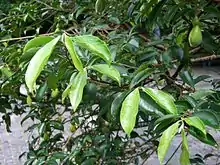Aquilaria
Aquilaria is a genus of fifteen[1] species of trees, called lign aloes or lign-aloes trees, in the family Thymelaeaceae, native to southeast Asia. They occur particularly in the rainforests of Indonesia, Thailand, Cambodia, Laos, Vietnam, Malaysia, Northeast India, Bangladesh, the Philippines, Borneo and New Guinea. The trees grow to 6–20 m tall. The leaves are alternate, 5–11 cm long and 2–4 cm broad, with a short acuminate apex and an entire margin. The flowers are yellowish-green, produced in an umbel; the fruit is a woody capsule 2.5–3 cm long.
| Aquilaria | |
|---|---|
 | |
| Aquilaria sinensis leaves | |
| Scientific classification | |
| Kingdom: | Plantae |
| Clade: | Tracheophytes |
| Clade: | Angiosperms |
| Clade: | Eudicots |
| Clade: | Rosids |
| Order: | Malvales |
| Family: | Thymelaeaceae |
| Subfamily: | Thymelaeoideae |
| Genus: | Aquilaria Lam. |
The genus is best known, together with Gyrinops, as the principal producer of the resin-suffused agarwood used in aromatic incense production, especially Aquilaria malaccensis.[1][2] The depletion of wild trees from indiscriminate cutting for agarwood has resulted in the trees being listed and protected as an endangered species.[1][2][3] Projects are currently underway in some countries in southeast Asia to infect cultivated Aquilaria trees artificially to produce agarwood in a sustainable manner.[3] In Indonesia, for example, there have been proposals to encourage the planting of gahara, as it is known locally, in eastern Indonesia, particularly in the province of Papua.[4]
Species

- Aquilaria acuminata (Merr.) Quisumb., originally Gyrinopsis acuminata
- Aquilaria apiculata Merr.
- Aquilaria baillonii Pierre ex Lecomte & Leandri
- Aquilaria banaensae Phamh.
- Aquilaria beccariana Tiegh
- Aquilaria brachyantha (Merr.) Hallier f.
- Aquilaria citrinicarpa (Elmer) Hallier f.
- Aquilaria crassna Pierre ex Lecomte
- Aquilaria cumingiana (Decne.) Ridl.
- Aquilaria filaria (Oken) Merr.
- Aquilaria grandiflora Benth.
- Aquilaria hirta Ridl.
- Aquilaria malaccensis, Lam., synonyms A. agallocha and A. secundaria[3]
- Aquilaria microcarpa Baill.
- Aquilaria ophispermum Poir.
- Aquilaria parvifolia (Quisumb.) Ding Hou
- Aquilaria pentandra Blanco
- Aquilaria rostrata Ridl.
- Aquilaria rugosa K.Le-Cong & Kessler
- Aquilaria sinensis Gilg
- Aquilaria subintegra Ding Hou
- Aquilaria urdanetensis Hallier (Philippines)
- Aquilaria yunnanensis S.C.Huang
References
- Ng, L.T., Chang Y.S. and Kadir, A.A. (1997) "A review on agar (gaharu) producing Aquilaria species" Journal of Tropical Forest Products 2(2): pp. 272-285
- Barden, Angela (2000) Heart of the Matter: Agarwood Use and Trade and CITES Implementation for Aquilaria malaccensis TRAFFIC International, Cambridge, ISBN 1-85850-177-6
- Broad, S. (1995) "Agarwood harvesting in Vietnam" TRAFFIC Bulletin 15:96
- Theresia Sufa, 'Gaharu: Indonesia's endangered fragrant wood', The Jakarta Post, 2 February 2010.
